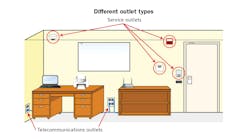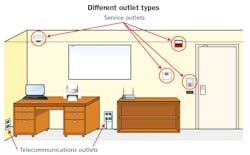The swarm of everyday devices and applications connecting to the network is changing everything in the information and communications technology (ICT) world. Known as the Internet of Things (IoT), IP-connected devices are creating a constant challenge to the design and implementation of new technologies in all industries. Like a fast-moving snowball, there is no way to slow down or keep up with this continuum. This year everyone has gained a better respect and dependency on the internet as we have grasped its impact in everyday life. It is now known as the 4th utility.
In the enterprise space, architects working with network system designers are realizing the benefits of integrated systems on the network to create intelligent buildings. An intelligent building utilized communication technology through Internet Protocol (IP) addresses to share a common network infrastructure. As innovation occurs, systems and applications that have traditionally been connected to separate networks and proprietary protocols are now using Ethernet as the common platform to intelligently “talk” to each other with very little human interaction. As a result, a well-designed and integrated intelligent building provides an environment that is more comfortable, productive and cost effective.
The cabling infrastructure is the foundation of an intelligent building. Understanding the data and power requirements (Power over Ethernet—PoE) of these applications is mind-spinning because of constant technology changes. Luckily, there is help for ICT professionals, including system designers and contractors, through the understanding of standards. Standards are the platform of all telecommunications networks because they establish guidelines and recommend best implementation practices from network design to installation to verification. Standards establish technical criteria and ensure uniformity and compatibility between networks, even multivendor networks, and are based on the experience and knowledge of their constituents and manufacturers.
An insight into ANSI/BICSI 007
BICSI recognizes the need to provide standardized guidelines for the design, installation and integration of ICT systems and related telecommunications fields. The originally published ANSI/BICSI 007-2017 Information Communication Technology Design and Implementation Practices for Intelligent Buildings and Premises standard was intended to be used for any size building. This standard was written for use in the design and implementation of the structured cabling systems used to support building or premises systems, which can be integrated through the use of a common infrastructure.
This standard can be used to determine design requirements in conjunction with the system owner, occupant, or other project consultants. This standard provides a reference of common technology and design practices but is not intended to be used by design professionals as their sole reference or as a step-by-step design guide, rather to be used with other complementary standards, documents and codes, such as the National Electrical Code, TIA and ISO standards, and CSI’s MasterFormat.
ANSI/BICSI 007-2020 was recently updated to address changes in design methodology, advancements in technology, and include additional IP-enabled systems within and around the enterprise building. Utilizing more than 35 core subject matter experts and a public review engaging 100 more across 17 countries and 6 continents, content was expanded by 40%. “We knew when the first version was published in 2017 as a working document, that the Intelligent Building Standards Committee would immediately start working on the updates,” states Todd Taylor, president of BICSI, who also served years as a member and chair of the BICSI Standards Committee.
Cornerstone of intelligent building
At the turn of this century, IP cameras were developed and deployed over the Ethernet network. This was one of the first applications outside of data and voice communications, which opened the doors for additional disparate devices, which previously ran over proprietary systems, to also jump onto the network. In addition, IP cameras could be PoE-powered over the same cable, which made them even more desirable.In 2009, BICSI published the first Electronic Safety and Security Design Reference Manual (ESSDRM) and a corresponding credential for ICT professionals to provide best design and installation practices. In 2013 BICSI followed up with the standard ANSI/BICSI 005 Electronic Safety and Security System Design and Implementation Best Practices. This standard was one of the first initiatives addressing the specification of a physical cabling infrastructure for electronic safety and security systems. The scope of the standard applied to systems provided by physical security professionals and included safety systems (i.e. fire detection and suppression, emergency mass notification), physical access control, video surveillance and intrusion detection systems.
One of the biggest changes to ANSI/BICSI 007-2020 is that all applicable ESS information from BICSI 005 has been incorporated since security systems are considered the cornerstone of intelligent buildings. In doing so, ANSI/BICSI 005 has been withdrawn from circulation and further revision as a standard.
The expanded ESS section in the BICSI 007 also includes the different levels of building security in relation to physical access control, monitoring of access, power connection and cabling security levels and provides an example of a security profile for a single building.
Cabling and connectivity
Primary decisions for the cabling type (optical fiber and copper) are based on application requirements, signal type, distance and location, power requirement, and longevity of building occupancy. It is important when selecting the cable that the cable is reviewed on its signal strength to provide excellent insertion loss performance while minimizing noise through superior crosstalk performance. For new installations, the selected cable shall follow all other applicable existing standards’ requirements and recommendations, such as TIA and/or ISO/IEC.
Optical fiber cable offers many advantages over twisted-pair cable as it has the ability to transmit higher bandwidths over greater distances. Supported optical fiber cabling media includes OM3, OM4, and OM5 multimode fiber, and all forms of singlemode fiber.
Horizontal cabling to the devices should be planned to accommodate future equipment needs, which includes transitioning from proprietary systems to IP-based structured cabling, increased system bandwidth requirements, and the need to provide or increase power. If twisted-pair copper cable is to be used, all classes from Category 6/Class E and up are recognized but Category 6A/Class EA or higher performing cabling is recommended. While Category 8/Class I/II cabling is an accepted standard, it was mainly developed for high-bandwidth and short distances specified mainly for data centers and it is not commonly used for intelligent building applications at this point. BICSI 007 also acknowledges that some building systems may require other unique cabling to suit the environment, application and distances.
BICSI 007 defines outlets in two categories: telecommunications outlets (TO), used primarily for end devices that are administered by the user (i.e. computer, phone), and service outlets (SO) for non-telecommunications devices (i.e. door controller, sensors, access points or security cameras), which are dependent on the application and location of the service. One of the many differences is that the location of SOs aren’t feasible to include a jack-outlet-patch cord work area scenario and may need to be directly connected to the device itself. Both the BICSI 005 and 007 were early adopters for a plug-ended horizontal cable. This method is now known as modular plug terminated link (MPTL) and is also approved by TIA.
Evolution of zone cabling
Zone cabling evolved from the open office concept for flexibility and to simplify moves, adds and changes near the work area. At that time, it was referred to as a consolidation point for an additional crossconnection point. Today zone cabling is a very viable option for intelligent buildings because it allows horizontal cable pulled to the zone enclosure, referred to as a horizontal connection point (HCP), and then additional cable installed to the end device on an as-needed basis. Unlike a consolidation point, an HCP for intelligent buildings may contain active and passive equipment. The other alternative to zone cabling would be homerun pulls from the telecommunications rooms (TRs), which would be more costly and require more lengthy copper cable runs.
The revised BICSI 007 has expanded the section on design considerations for zone enclosures to include more options and topologies for horizontal cabling and contains diagrams and layouts that depict examples of a star topology (point-to-point), zone cabling, different coverage area patterns, and tree topology.
Let there be low-voltage lighting
Traditional lighting systems were previously standalone and installed only by licensed electricians. With the integration of occupancy and light sensors, a lighting system can be integrated with other building systems to provide enhanced occupancy control and comfort. LED lights consume much less energy than other types of lamps as it uses low-voltage DC current from a central controller typically using PoE. Since power can be delivered to the lights while not exceeding the IEEE-defined PoE power limit of 90W, the majority of states allow low-voltage contractors to install these systems, which usually results in reduced installation costs for the building owners.
The BICSI 007 provides detailed information and diagrams on the different types of lighting methods in regard to lighting loads, sensors and controllers. In addition, the standard provides recommended cabling types with best installation practices for lighting and PoE, especially the effects of heat on the cable’s performance, especially in bundling. A new section details the integration of lighting and AV, and provides best recommendations on energy reduction and lighting guidelines.
AV systems, which were listed previously under “Other Systems” are incorporated in a new, dedicated section that addresses the many AV applications that can be controlled over an IP address. These include notification systems, sound masking, intercom, emergency communication, digital signage and wayfinding.
Putting the pieces together
The expanded section on “System Integration” details the entire integration process from design considerations, software, response time and a step-by-step process for developing a matrix, integration plan, testing and commissioning. The standard provides a detailed matrix as well as visual examples of the topology and protocols of these integrated systems, such as the example diagram.
Additional expanded Informative Annexes added to BICSI 007 include the following.
- Reliability for ICT Infrastructure—adopted from the ANSI/BICSI 002 data center standard, this section details the different availability classes showing how redundant pathways, spaces and cabling can be configured
- Network Design and Security—an overview of threats and countermeasures for network security as it relates to IP-based system design
- Cloud Computing Services—models for intelligent buildings
- System Training—outlines a plan for training of different administrators, officers, managers and IT staff and officers
- Light Fidelity Technology—known as LiFi, a relatively new application uses LED lights to transmit LiFi wireless signals that transmit short distances and up to 15 Gbits/sec to transmit data between devices through light output
What’s next
Integrating intelligent building systems needs to be a collaboration among IT, the facilities or the building operations manager (i.e. operational technology or OT), the client, the low-voltage contractor and, of course, the manufacturers as solution providers. The IT team can make the convergence happen, but creating an intelligent building needs to involve the teamwork of all these resources from start to finish.
The list of possible integrated systems is only limited by the capability of the specific system, codes and regulatory issues. Just as important as the layout of the systems and placement of the termination equipment is the need to select an efficient building operating system including infrastructure management tools to gather, monitor and aggregate data from the multiple subsystems within a facility. The ANSI/BICSI 007 standard provides operational information on building management tools.
“Since technology is continually evolving, it is challenging for published standards to stay ahead of these changes,” states John Daniels, CNM, FACHE, FHIMSS, CPHIM, BICSI’s chief executive officer and executive director. “But this standard, much like the basis for most of the standards by BICSI, provides the infrastructure groundwork for network design, application requirements and best installation practices, which are constant,” he adds. ICT professionals should always stay on top of education and possess a library of resources to give them the competitive advantage. The revised ANSI/BICSI 007-2020 is available online or as a hard copy at bicsi.org/007.
Carol Everett Oliver, RCDD, DCDC, ESS is the principal of CEO Communications, an ICT consulting and marketing firm, and a frequent contributor of technical articles. She is chair of the BICSI Intelligent Building Standards Subcommittee and has served on BICSI’s board of directors as Northeast Region Director and Secretary. She currently is BICSI’s President-Elect, for the 2020-2021 term.



